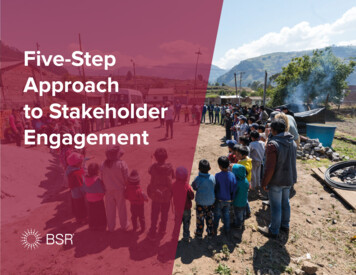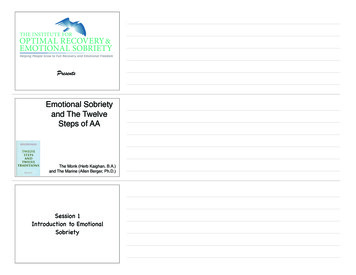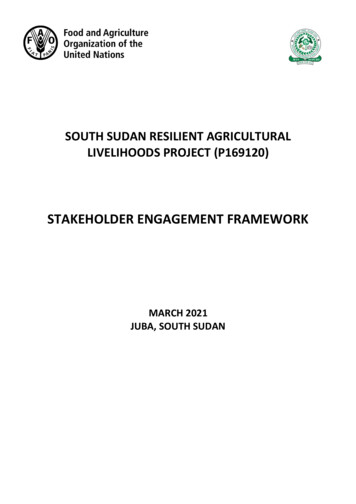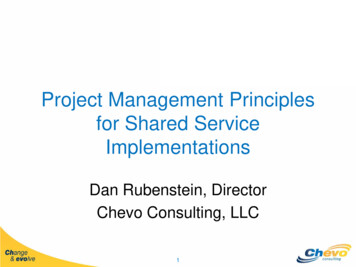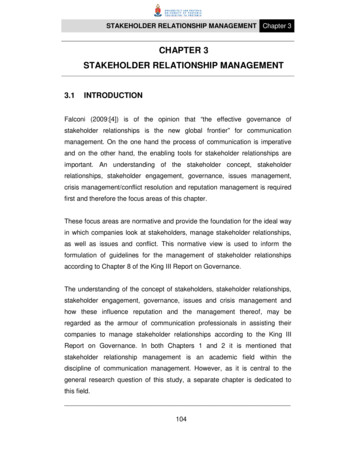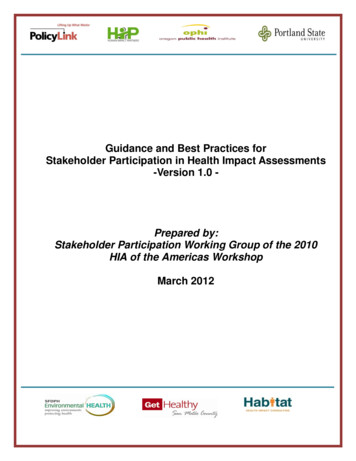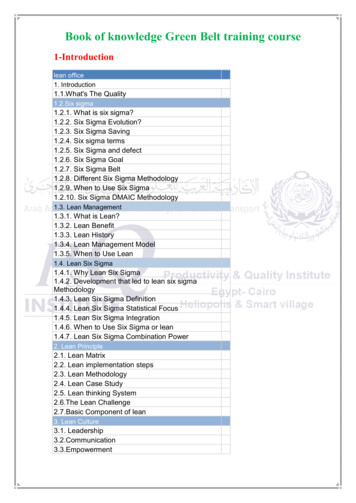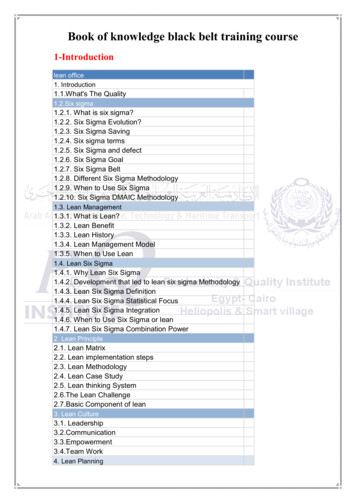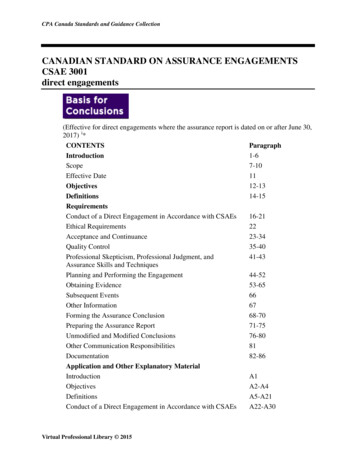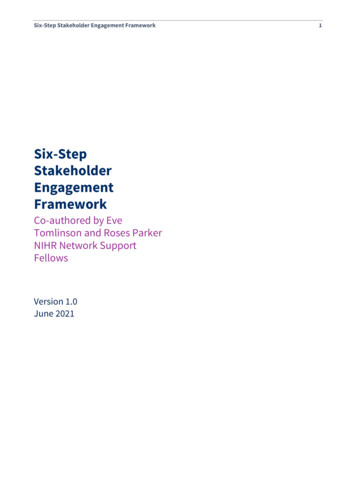
Transcription
Six-Step Stakeholder Engagement authored by EveTomlinson and Roses ParkerNIHR Network SupportFellowsVersion 1.0June 20211
Six-Step Stakeholder Engagement FrameworkTable of Contents21.Background32.The Six-Step Stakeholder Engagement Framework52.1Step One: Be clear about the purpose for stakeholder engagement62.2Step Two: Reflect on previous stakeholder engagement and consider capacity82.3Step Three: Identify relevant stakeholders92.4Step Four: Connect with stakeholders112.5Step Five: Report stakeholder engagement142.6Step Six: Evaluation and dgements206.References20
Six-Step Stakeholder Engagement Framework31. BackgroundStakeholder engagement in health research is vital to ensure research is relevant, accessible, and useful toend-users. There is growing acceptance that engagement of stakeholders in health research has wide reachingbenefits. Examples of these benefits can be seen in Table 1 below and include improving research quality (Involve,2013) and relevancy (Kreis et al., 2013), promoting uptake in the use of research in healthcare decision making andreducing research waste (Graham et al., 2018).Cochrane recognises the importance of stakeholder engagement in health research. Cochrane editorial policy states that Cochrane systematic reviews should undergo peer review and have atleast one consumer peer review.The Cochrane "Guidance note for Cochrane Groups to define systematic review priorities" states that it ismandatory to involve at least one stakeholder in review priority setting exercises (Foxlee et al., 2018).In 2018 Cochrane adopted the Statement of Principles for Consumer involvement as Cochrane Policy.Cochrane aims to work closely with consumers to make Cochrane content understandable and accessibleworldwide.This document outlines a Six-Step Stakeholder Engagement Framework, proposed to support Research Groupswith stakeholder engagement, regardless of their previous experience. We use the term “Research Groups” to represent groups of researchers looking to expand their stakeholderengagement. This may include Groups from within Cochrane, such as Review Groups, Fields, GeographicGroups, and Methods Groups. It may also include researchers from outside of Cochrane, for example basedwithin Universities and healthcare institutions. We use the term “stakeholder” to mean “an individual or group who is responsible for, or affected byhealth- and healthcare-related decisions” (Concannon et al., 2019). We use the term “engagement” to mean “an active partnership between stakeholders and researchers inthe research process” (Staniszewska et al., 2017).The Six-Step Stakeholder Engagement Framework has been proposed as a pragmatic process that could beconsidered when initiating stakeholder engagement in a wide array of projects. Examples include one off events(such as the co-production of systematic review), broader projects (such as the prioritisation of systematic reviewtopics by a Cochrane Review Group), and stakeholder engagement over a sustained period covering severaldifferent areas (such as to support the direction or focus of a Research Group and to disseminate research).We recognise that stakeholder engagement can come with challenges, particularly when resources are limited.However, stakeholder engagement is crucial to offer new perspectives, learning and relevance to health research.In this Framework we are therefore keen to highlight that there is not a neat ‘one size fits all approach’ tostakeholder engagement but many ways researchers could engage stakeholders in their work. In line withthis, the Framework aims to cover common and key steps in the engagement process, provide a helpful structure,and raise important considerations for stakeholder engagement, whilst encouraging modifications to be madebased on the individual Research Group’s circumstance.The Framework has been produced by Roses Parker and Eve Tomlinson, the Network Support Fellows for theCochrane Musculoskeletal, Oral, Skin, and Sensory (MOSS) Network and the Cochrane Cancer Network.Development of the Framework was initiated after realising a need for more support with stakeholderengagement in Cochrane, following discussions within both the MOSS and Cancer Networks. This Framework isnot official Cochrane guidance, and it is not based on a rigorous literature search. However, in conjunction with theexperiences of the writers, it has had input from a range of sources, including insights from individuals from
Six-Step Stakeholder Engagement Framework4Cochrane Review Groups, individual consumers working with the MOSS Network, the Cochrane Central Executiveteam, the Cochrane Consumer Network, and the Cochrane Knowledge Translation department. Furthermore, atleast one person from the editorial base of each Cochrane Review Group in the MOSS Network was interviewedabout their experiences of stakeholder engagement. These case studies are neither all encompassing, nor meant tobe a “gold standard” but they are intended to accompany this Framework as a useful resource and can be foundhere.The Framework has also been informed by key resources, referenced throughout, such as the ACTIVE Framework(Pollock et al., 2019) and accompanying Cochrane resource Involving People. ACTIVE was designed to supportauthors of systematic reviews in stakeholder engagement in review production. Conversely, this Six-StepStakeholder Engagement Framework is designed to support Research Groups with stakeholder engagement inmany areas of functioning, including review production but also in other activities such as the priority setting ofreview titles or in developing awareness of Cochrane in the relevant academic and clinical area. Nevertheless, thebasic principles of stakeholder engagement from the ACTIVE framework apply and we encourage readers to usethese resources, in addition to other resources listed in Section 4.T ABLE 1: EXAMPLES OF THE POTENTIAL BENEFITS OF ENGAGING STAKEHOLDERSStakeholderPotential benefits of increased engagement Promotes transparency, accountability, and trust in the way that research is produced(Cochrane Consumer Network, 2017).Results in evidence that addresses consumers’ needs (e.g., relevant outcomes identified),reduces waste in research, improves the translation of research into policy and practice,and ultimately leads to improved benefits for health systems and outcomes for patients(Cochrane Consumer Network, 2017).Is consistent with current health research approaches and is expected or mandated byresearch funders, partners, and consumers (Cochrane Consumer Network, 2017).Results in improved awareness of Cochrane evidence among consumers and the public. Results in evidence that is relevant to practitioners.Clinical practice is influenced by the best available evidence.Practitioners are better able to support patients in treatment decisions.Improved awareness of Cochrane research among practitioners. Results in evidence that is relevant to policy makers and healthcare managers.Improved contextualisation of Cochrane evidence so that it can be used in guidelines andpolicy.Improved awareness of Cochrane research among policy makers and healthcaremanagers. Consumersand thepublic PractitionersPolicymakers andhealthcaremanagersResearchersand researchfunders Results in evidence that is relevant to researchers and research funders.Primary research that is better designed to fit knowledge gap and research needs.Increased recruitment of authors, as researchers may choose to publish systematicreviews with Cochrane.Increased dissemination of Cochrane reviews, leading to increased citations and othermeasures of reach.Opportunities for funding of future projects.Improved awareness of Cochrane research among researchers and research funders.
Six-Step Stakeholder Engagement Framework52. The Six-Step Stakeholder Engagement FrameworkThe Six-Step Stakeholder Engagement Framework is formatted around the taxonomy from The CochraneKnowledge Translation Framework (Cochrane, 2017), which describes four types of stakeholder. Note: thedefinition of policy makers and healthcare managers, and researchers and research funders has been adaptedslightly for the purposes of this document, due to this Framework not focusing solely on knowledge translation.-Consumers and the public: those seeking health care, their families and carers, and the public.Practitioners: of health care including clinicians and public health practitioners.Policy makers and healthcare managers: individuals and organisations responsible for purchasinghealthcare and making higher level decisions about healthcare availability and advice.Researchers and research funders: those involved in designing, conducting, commissioning, and carryingout research.The Framework consists of six steps, spanning the process of stakeholder engagement from the planning ofengagement (step 1: be clear about the purpose for stakeholder engagement, step 2: reflect on previousstakeholder engagement and consider capacity, step 3: identify relevant stakeholders), to engaging stakeholders(step 4: connect with stakeholders) and considerations following engagement (step 5: report stakeholderengagement, step 6: evaluation and maintenance) (Figure 1).Step 1: Be clearabout the purposefor stakeholderengagementStep 6: Evaluateand maintainstakeholderrelationshipsStep 2: Reflect onprevious stakeholderengagement andconsider capacityStep 5: ReportStep 3: tep 4: Connectwith stakeholdersF IGURE 1: S IX STEPS TO STAKEHOLDER E NGAGEMENT
Six-Step Stakeholder Engagement Framework2.16Step One: Be clear about the purpose for stakeholder engagementIn step one, it is important to first be clear about the purpose for stakeholder engagement and to clarify theobjective(s) for reaching out to stakeholders. Stakeholder engagement can be beneficial in all research activitiesand potential benefits are outlined in Table 1. Each project may hold multiple overlapping purposes and furtherunanticipated benefits may be uncovered as the work progresses. Examples of research activities and projects inwhich stakeholders could be engaged include:- Prioritising topics for Cochrane reviews that are important to stakeholders.- Helping in the production of specific reviews (e.g., co-production or peer review).- Applying a health equity focus to research production.- Supporting dissemination/ use of evidence with a specific target audience.- Developing or running training for specific target audiences.- Identifying new Cochrane authors with an interest in a specific topic.- Guiding the Research Group in direction setting for Group activities.- Funding Research Group activities.- Creating an "Evidence Ecosystem" (Ravaud et al., 2020) in which the community of clinical trialists,evidence synthesisers, and guideline developers work together to provide a full cycle of evidence.Further ideas of the purposes of stakeholder engagement and Research Groups’ experiences within Cochrane canbe found in this report of stakeholder engagement in MOSS CRGs.In this early step, it is important to think about the potential impact that stakeholder engagement is likely to haveon the research project and to be aware that there is the possibility that stakeholder engagement mayinadvertently negatively impact on health equity, defined as absence of avoidable and unfair differences in health(Welch et al., 2019), if not intentionally addressed. It is therefore important to keep this in mind when embarking onstakeholder engagement, and throughout the steps in the Framework, to try to ensure that your approach isequitable.It may be useful to refer to Cochrane’s “Involving People” online resource, specifically the module on “general goodpractice when involving people”, in this first step of the stakeholder engagement process. Though the focus of thismodule is systematic review production, the points covered can be applied more widely. Whilst clarifying yourResearch Group’s purpose for stakeholder engagement, also consider the following two points from the ACTIVEFramework and related Involving People resource:--What is the desired mode of stakeholder involvement in your work?o This refers to the general way in which you want to involve stakeholders in your project. Forexample, will you approach engagement by seeking one-time stakeholder involvement,continuous involvement or combined (i.e., both one-time and continuous)? Will you seek directinteraction with stakeholders or no direct interaction with stakeholders?What is the desired level of stakeholder involvement your work?o This refers to the extent to which stakeholders are involved in your work. For example,stakeholder involvement in research can be considered as a continuum with stakeholders leadingthe project as the highest level of involvement (i.e. lead responsibility for the project), thencontrolling (i.e. making decision and/or controlling one or more aspects of the project incollaboration with other members), influencing (i.e. advising or providing information but withoutdirect control over decisions), contributing (i.e. providing views, thoughts, feedback, opinions orexperiences), then finally receiving (i.e. receiving information about the project or project results)as the lowest level of involvement.
Six-Step Stakeholder Engagement Framework7It would also be useful to consider the timing of stakeholder engagement. For example, information gathered frominterviewing a sample of five consumers who work with CRGs in the MOSS Network highlighted that someconsumers said they would want to be involved right from the beginning, as it may be that they have a differing anduseful perspective on what is needed and the purpose of the work. Whereas others might rather wait until theresearch project had a defined shape.Overall, as a Research Group, you need to be open to stakeholder input. It is important to take the time tounderstand your stakeholder’s preferences and try to reach a mutual decision with your stakeholders about thedesired mode, level, and timing of engagement, whilst also keeping in mind that it may not be necessary to engageall stakeholder groups outlined in Figure 1 in the same way.
Six-Step Stakeholder Engagement Framework2.28Step Two: Reflect on previous stakeholder engagement and considercapacityReflect on previous stakeholder engagementAfter outlining the purpose for stakeholder engagement, it may be beneficial to reflect on previous and/or currentstakeholder engagement. Considering past successes and challenges will help inform future engagement work.Some questions to consider are:-What has worked well in previous stakeholder engagement? Did we fulfil our objectives? Was theengagement useful for the Research Group and the stakeholder?What have been challenges in previous stakeholder engagement? What could we do differently tomaximise impact and use resources effectively?Is it important to initiate new stakeholder engagements, or reinitiate partnerships that may have faded?Is it possible that past stakeholder engagements have inadvertently added to health inequities, forexample by not including a diverse stakeholder group?Consider capacityCapacity is likely to vary between individuals in the Research Group and may differ depending on the time of year orother projects currently being undertaken. It is important to be aware of potential limits on your capacity forundertaking stakeholder engagement, to ensure that you can initiate stakeholder engagement, act on stakeholderinput and manage the relationships you develop sustainably.Research Groups should not be discouraged if capacity is low; this Framework is designed to increase stakeholderengagement within current capacity. We encourage you to aim for a level of engagement you can feasibly achievewith the resources you have, learn from the experience, and perhaps try to think about long-term stakeholderengagement goals and plan for funding to achieve them. For example, if you have limited resources you mightdecide to work with multiple stakeholders but on shorter and less involved partnerships (see Section 2.1 forconsideration about levels and approaches to involvement), work with one or two key stakeholders only, or seekpartnerships with stakeholders who have the capacity to lead the work or have funding to support you in doing thework. Examples of stakeholder engagement from Research Groups with a range of differing capacities can be foundin this report of stakeholder engagement in MOSS CRGs.When considering capacity, it may also help to anticipate level of impact stakeholder engagement is likely to yield(high, or low) in the research project compared to anticipated level of effort from Research Group and stakeholderfor engagement (high, or low). See Table 2 (Mind Tools, 2021). Note that ranking should be based on the specificobjectives which stakeholder engagement could produce and stakeholder engagement work should be planned toachieve these results.T ABLE 2: R ANKING USING EFFORT AND IMPACT ASSESSMENTSHigh impactLow impactHigh effortMajor projectTime wasterLow effortQuick winFill-in project
Six-Step Stakeholder Engagement Framework2.39Step Three: Identify relevant stakeholdersStep three of the stakeholder engagement process involves identifying relevant stakeholders to engage in yourwork. As a Research Group, you will need to make an active effort to identify and engage stakeholders, rather thanwait for stakeholders to come to you. This step is likely to differ depending on whether you are aiming to identifyindividuals to involve in a specific research project or more generally, to identify organisations that may be ofrelevance to your Group.When identifying stakeholders, it is first important to consider which broad stakeholder type(s) you want to engage.You can do this by selecting from the stakeholder types outlined in the Cochrane Knowledge TranslationFramework (Section 2.1 ) or from the stakeholder type framework of your choice (Concannon et al., 2019). Whetheryou want to focus your efforts on one or more stakeholder types will be driven by your collaboration needs andyour capacity. There is often overlap between stakeholder types and roles may not be tidy and structured, forexample a researcher may also be a patient. If you are aiming to find a stakeholder to represent a certainstakeholder type (e.g., policy makers and healthcare managers), it is important to remember that whilst this can bemutually agreed with the stakeholder, each individual brings a unique set of experiences and cannot be expectedto represent all views within a stakeholder group.It may be useful to consider the following questions in regards to each of the stakeholder types to decide if it isimportant to involve them in your work (Concannon et al., 2019):-What decisions do they make?How are they affected by your work?What is the number of people you would like to and can realistically engage (considering budget)?Identifying organisationsOnce you have decided on the stakeholder types you will involve, you can start to work on finding them! It may beuseful to create a “map” or list of specific stakeholders to connect with. Stakeholder mapping can help you tovisualise who your key stakeholders are and can be particularly useful if you are aiming to map out organisations.In this instance, you might benefit from gathering details of organisations contributing to relevant guidelines,searching organisation’s websites, and using social media to find out more about their scope, key personnel, andreach. Using this type of “systematic selection” (Haddaway et al., 2017) you can map out relevant organisationsinto a table or spreadsheet. See Table 3. If stakeholder maps are created, it is important to keep them up to date ifthey are to be used again, as stakeholder information and relevance of stakeholders to your Research Group islikely to change over time. An example of a stakeholder mapping process using these methods in the CochraneCancer Network can be found in Section 4.
Six-Step Stakeholder Engagement Framework10T ABLE 3: METHODS OF STAKEHOLDER IDENTIFICATION (H ADDAWAY ET AL., 2017)Method of selectionDescriptionPurposiveIdentifying and inviting specific stakeholders based on criteria determined byresearchers in relation to the specific project.SnowballingUsing a list of stakeholders who are then asked to suggest further stakeholders whocontinue to suggest further stakeholders.Open callUsing a public forum, often social media, to advertise for stakeholders.SystematicSystematic identification of stakeholders mirroring methods to identify research insystematic reviews. This method is least likely to lead to biased stakeholder groupsbut is resource intensive.Identifying individualsIf you do not have the resources to complete an in depth identification process, or you are aiming to identify a fewkey individuals to work with, for example to be involved in a specific one-off project or systematic review,“purposive selection” or the use of known contacts may be useful (Haddaway et al., 2017). See Table 3. You maywish to think about organisations or individuals relevant to your work and speak to colleagues to find mutualconnections. If you already have a few stakeholder connections then it may be helpful to reach out to them at thisstage - not necessarily to pursue their specific involvement but because they may insights into methods ofstakeholder identification you are unaware of and may be able to suggest individuals or organisations you wouldotherwise not have considered.Cochrane Review Groups have also found their editors a helpful source of information at this stage and Cochrane'sTaskExchange may provide needed capacity (See Section 4 for links to a report of MOSS CRG experiences andTaskExchange). Cochrane’s Involving People resource also gives tips on identifying people to involve in systematicreview production. Note: consumers have pointed out to us that it is helpful to involve more than one consumer asthere is a lot of pressure being the only one and if someone drops out, it’s hard to catch up partway through. Thismay be true for other stakeholder groups as well.Once you have a map of relevant organisations and you want to select representatives from them or you have a listof individuals and want to select the most appropriate individuals to work with, you might find it useful to thinkabout what you are looking for in stakeholders to create a maximally effective researcher-stakeholder team. Forexample, you may want to consider the stakeholder’s expertise or experience, their communication skills, capacity,motivation, training requirements and equity and diversity in the team. This list is not exhaustive and there iscurrently ongoing work within the Multi-Stakeholder Engagement (MuSE) Consortium to expand on thisstakeholder selection guidance. This will be linked when available.
Six-Step Stakeholder Engagement Framework2.411Step Four: Connect with stakeholdersStep four involves connecting with stakeholders. This can seem daunting, and it can be difficult to know where tostart. However, completing steps 1-3 of this process ensures you are equipped for this stage as you will likely haveidentified stakeholders, have an accompanying list of objectives you wish to achieve through your engagement, anidea of the mode and level of stakeholder involvement you are seeking (see Section 2.1, and Involving People).Below you will find some tips for connecting with stakeholders.Seek out your stakeholders--Consider where you will find your stakeholders and be able to connect with them, rather than waiting forthem to come to you. Existing forums may be helpful to use to connect with stakeholders, for example:o Mumsnet for UK based parents.o Carer forums on Facebook or Instagram. Consider approaching the admin of the group who willhave a relationship with the members and can advise on the suitability of your request andpracticalities of how to engage their group.o Faith based institutions or organisation – these have been used successfully by researchers in thecovid-19 pandemic (Koenig, 2020; Merry et al., 2020; Tan et al., 2021; World Health Organisation,2020).Try to think beyond your own context to regions and settings effected by health inequality. CochraneGeographic Centres may help reach different geographic settings.Connect with stakeholders----Consider consulting colleagues to see if there are already existing relationships with the stakeholders youhave identified. This may be particularly relevant in the case of organisations. There may be an existingrelationship that needs to be understood before approaching.Go for it! Start small. It can be daunting but it’s good to jump in, whether it’s by email, letter or phoningsomeone up.Document your attempts - keeping track of when you have reached out to stakeholders and responsesreceived.If you don’t get an answer, follow up on your initial correspondence. It is good to be persistent with contactto maximise your chances of getting a response, but after 2 or 3 chasing emails, know when to stop! Don’tworry if you don’t get a positive response – there may be many reasons why an individual or organisationisn’t able to engage with you at this time.Be clear from the outset on what the project is, what you are expecting from the stakeholder, what you willoffer in return, timelines, and any other relevant information.Ensure that what you are proposing offers mutual benefit and be clear about what you are offering andwhat you want to achieve from the relationship.Building rapport is a critical part of the process. It can take a lot of investment to have a meaningfulconnection. It is important to listen to your stakeholder and find areas where your interests overlap.Be flexible with formality. We have heard from consumers in Cochrane that the formality of TaskExchangeand the rigid use of technologies like Archie and RevManWeb can be a barrier to engagement. Unless workwith Cochrane is a large part of their life, stakeholders may not want to spend the time learning thesetechnologies. Consider whether you can make engagement easier by using Word, PDFs, email, socialmedia platforms or even vlogs. Perhaps your stakeholder would rather just have an informal chat.Discuss the mode of involvement (i.e. leading, controlling, influencing, contributing, or receiving) and levelof engagement (i.e. continuous involvement, one-time involvement, combined involvement, top and tailinvolvement) that you wish to adopt in stakeholder involvement (Pollock et al., 2019). Be open about thisso you can come to a mutual agreement with your stakeholder.
Six-Step Stakeholder Engagement Framework--Work with your stakeholder to understand how much input they want from you. Some will want to begiven a task and left alone, others will appreciate regular check-ins. Ensure you have capacity for theirpreferred level of engagement. If you lack capacity, consider whether an existing or previous stakeholdercan act as a “buddy” for the new stakeholder.Be sensitive to the needs of others. This can be particularly crucial when engaging consumers in your work.If you are seeking input from someone with lived experience of a research area, it is important to be awareof possible sensitivities and to talk to people with experience of working with these groups prior toengagement. Talk to the individuals to understand their situation and any adaptions that might benecessary to accommodate their needs. You may need to consider support, training for consumer andteam members, compensation. Resources created by the Cochrane Consumer Network, including a guidefor authors involving consumers in reviews, may help you and these can be found in Section 5.Acknowledge stakeholder input and give something back-12Feedback to stakeholders throughout engagement as much as possible. This should include what youhave learned from them, what specifically you appreciated, how they have helped.Feedback in a timely fashion and keep them informed just as you would members of your own team.Feedback in an understandable way. Consider your language, presentation, and format.If you have offered certificates, badges, membership points, or any other notional or materialreimbursement, ensure this is provided. Do not leave it to the stakeholder to chase you on this.
Six-Step Stakeholder Engagement FrameworkQuick wins if capacity is lowNote: these quick wins all have limitations and should not be a substitute for carefully consideredstakeholder engagement. It is important to stress that tokenism in stakeholder engagement can bedamaging.------Leveraging existing relationships: Check to see if colleagues have existing relationshipswith relevant committees/ professional organisations/ academic institutions/ individuals. Itmay be appropriate to ask colleagues for contact details or an introduction to personaliseyour contact and give you a direct route into an organisation.Events: Network at events (even online events) to connect with stakeholders. If you aretrying to link in with an organisation, talk to people at events to find connections. They maynot be the right people, but it is likely that they will know of the right people to contact.Cochrane TaskExchange (https://taskexchange.cochrane.org/): Cochrane’s TaskExchangeplatform “connects people working in health evidence with people who have the time andskills to help”. This can help connect with stakeholders, especially consumers, on severalprojects including prioritisation, translation, and review production.Peer review: Most CRGs regularly use peer/consumer reviewers. These individuals may beable to help in other ways such as dissemination or providing introduction to otherstakeholders.Social media: Social media is increasingly important for healthcare users (Pershad et al.,2018). One potential platform,
Six-Step Stakeholder Engagement Framework 2 Table of Contents 1. Background 3 2. The Six-Step Stakeholder Engagement Framework 5 2.1 Step One: Be clear about the purpose for stakeholder engagement 6 2.2 Step Two: Reflect on previous stakeholder engagement and consider capacity 8 2.3 Step Three: Identify relevant stakeholders 9
